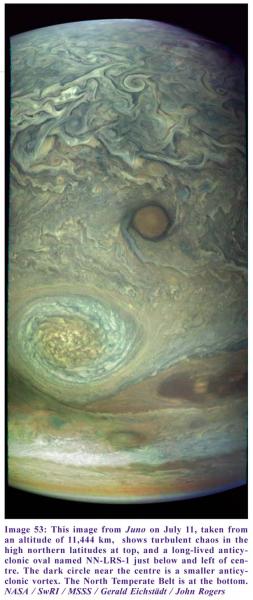NASA’s Juno provides spectacular views of Jupiter
2017 July 21
 NASA’s Juno mission has been proceeding perfectly since the last report in these pages [Journal vol.126(6), p.333 (2016)]. Aficionados of Jupiter have settled into a 53-day cycle of activity synchronised with Juno’s orbits. The spacecraft passed through its seventh close approach (perijove-7) on 2017 July 11, when it passed directly over the Great Red Spot, and took splendid close-ups of it including the one on the cover of this Journal.
NASA’s Juno mission has been proceeding perfectly since the last report in these pages [Journal vol.126(6), p.333 (2016)]. Aficionados of Jupiter have settled into a 53-day cycle of activity synchronised with Juno’s orbits. The spacecraft passed through its seventh close approach (perijove-7) on 2017 July 11, when it passed directly over the Great Red Spot, and took splendid close-ups of it including the one on the cover of this Journal.
Although the mission is primarily to study the interior of the planet, its most eye-catching results are those from the ‘public outreach’ camera, JunoCam. The quality of the images in mid-latitudes is now astonishing, surpassing the Voyager close-ups. At perijoves-5 and 6 they revealed a plethora of tiny bright clouds casting shadows, widespread over many regions of the planet, which had rarely if ever been seen before.
Images from amateur observers are essential for putting the spacecraft images in context, and are also used by the undersigned, in collaboration with the JUPOS team, to predict what will be visible under Juno’s track at the next perijove. Thus we recommend what imaging targets will be most worth voting for, and so far, our recommendations have all been ‘elected’. They include long-tracked ovals in various zones, and also belts which are changing with major cycles of activity. Juno images have monitored the North Temperate Belt (‘Big Red Stripe’), maturing after its spectacular revival late last year, and also the North Equatorial Belt (NEB), which has produced many convective storm outbreaks and has rapidly broadened to the north. Even when no specific features are targeted, the turbulent chaos of the high temperate latitudes is dazzling.
JunoCam’s images of the polar regions are revealing previously unknown features, now being studied by the mission’s scientists. Turbulent patches and small anticyclonic ovals are scattered throughout most of the polar regions, although there is a strange ‘bland zone’ at ~60-65°N, between the two most northerly jets, which contains long narrow haze bands. Other haze bands are widespread over the polar regions, sometimes appearing to cast brown shadows. At the poles themselves there are clusters of circular cyclones, quite unlike the poles of other planets.
Meanwhile the first science results, mainly from perijove-1, have been released by NASA and published. Of most relevance to those of us concerned with the atmosphere, the first north-south scan with the Microwave Radiometer has led to a surprising model for ammonia distribution in the deep atmosphere. It suggests that the visible pattern of belts and zones does not extend below the known cloud layers; instead, from there down to ~60 times Earth’s atmospheric pressure, there is a previously unsuspected layer, depleted in ammonia, except for enhancement (a rising plume?) under the northern equatorial zone and futher depletion (sinking?) under the NEB. If this model is confirmed by further observations and analysis, the planet’s dynamics will have to be re-thought. At even deeper levels, the first low-altitude pass through the gravitational and magnetic fields suggests that these also differ from expectations. It looks as though the Juno mission will indeed give important new insights into Jupiter’s interior.
NASA has decided to leave Juno in its present 53-day orbit, rather than risk firing the main engine again. Future perijoves will be on 2017 Sept 1, Oct 24, Dec 16, and 2018 Feb 7, April 1, May 24, July 16… and so on.
John H. Rogers, Director, Jupiter Section
| The British Astronomical Association supports amateur astronomers around the UK and the rest of the world. Find out more about the BAA or join us. |
